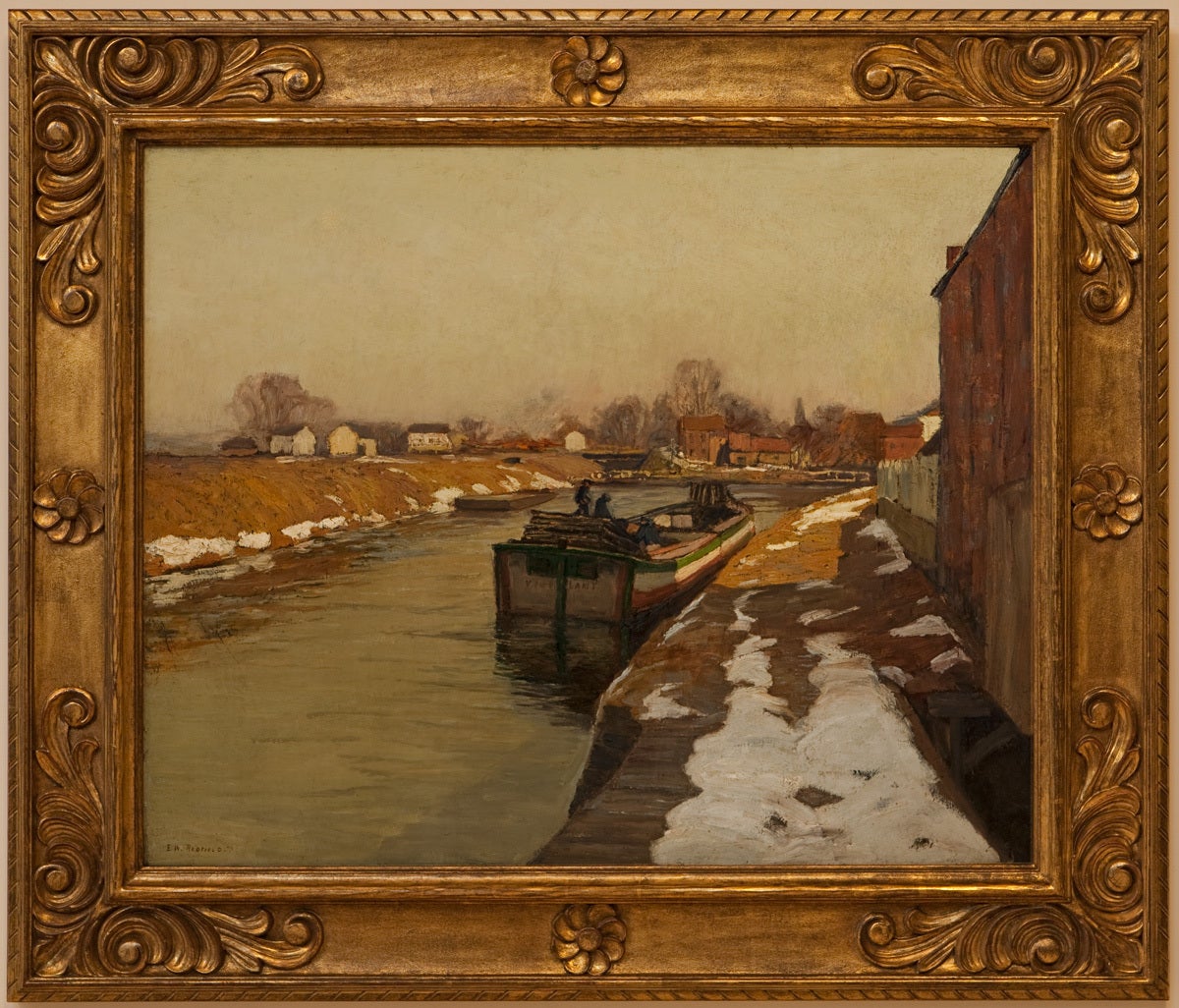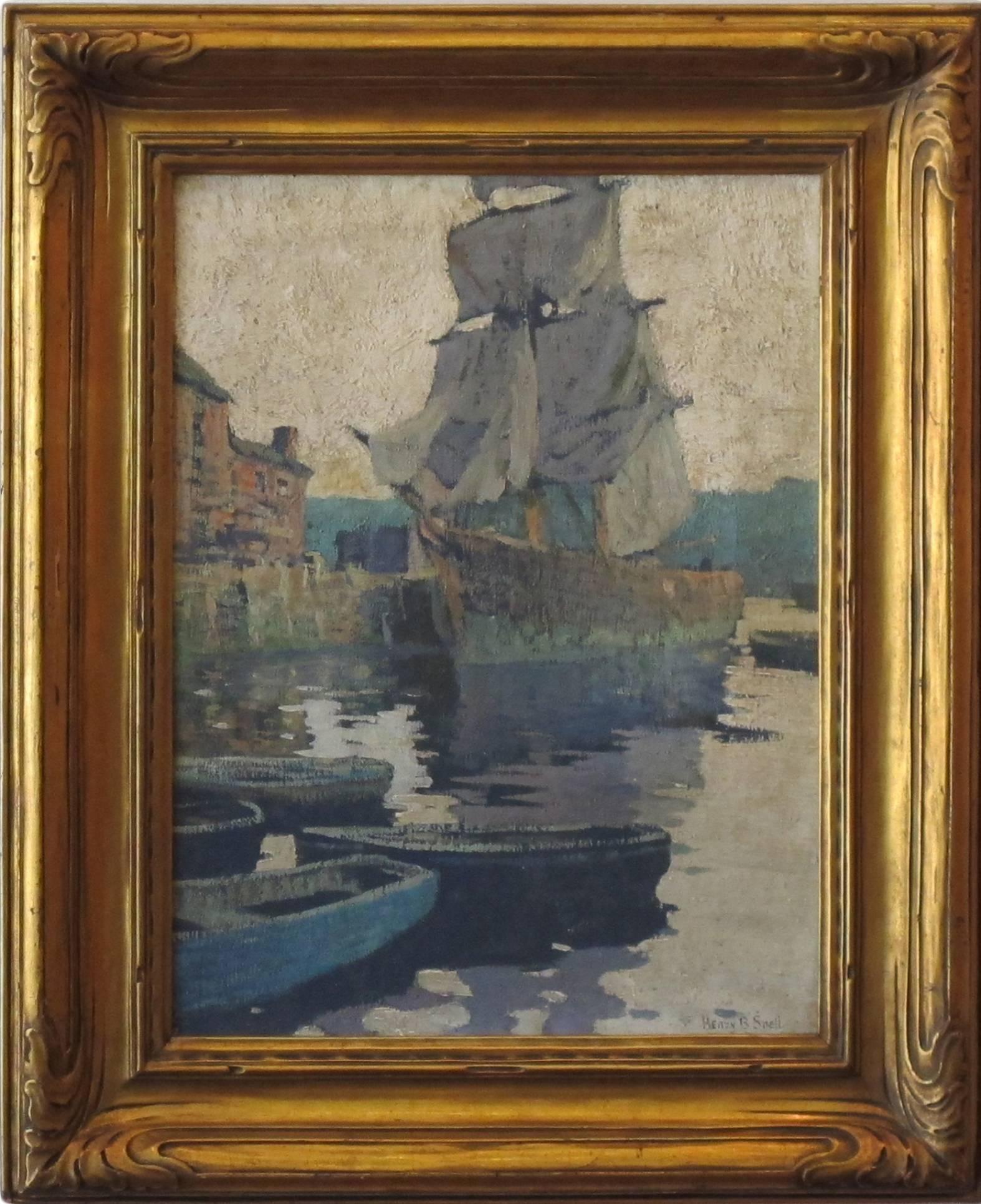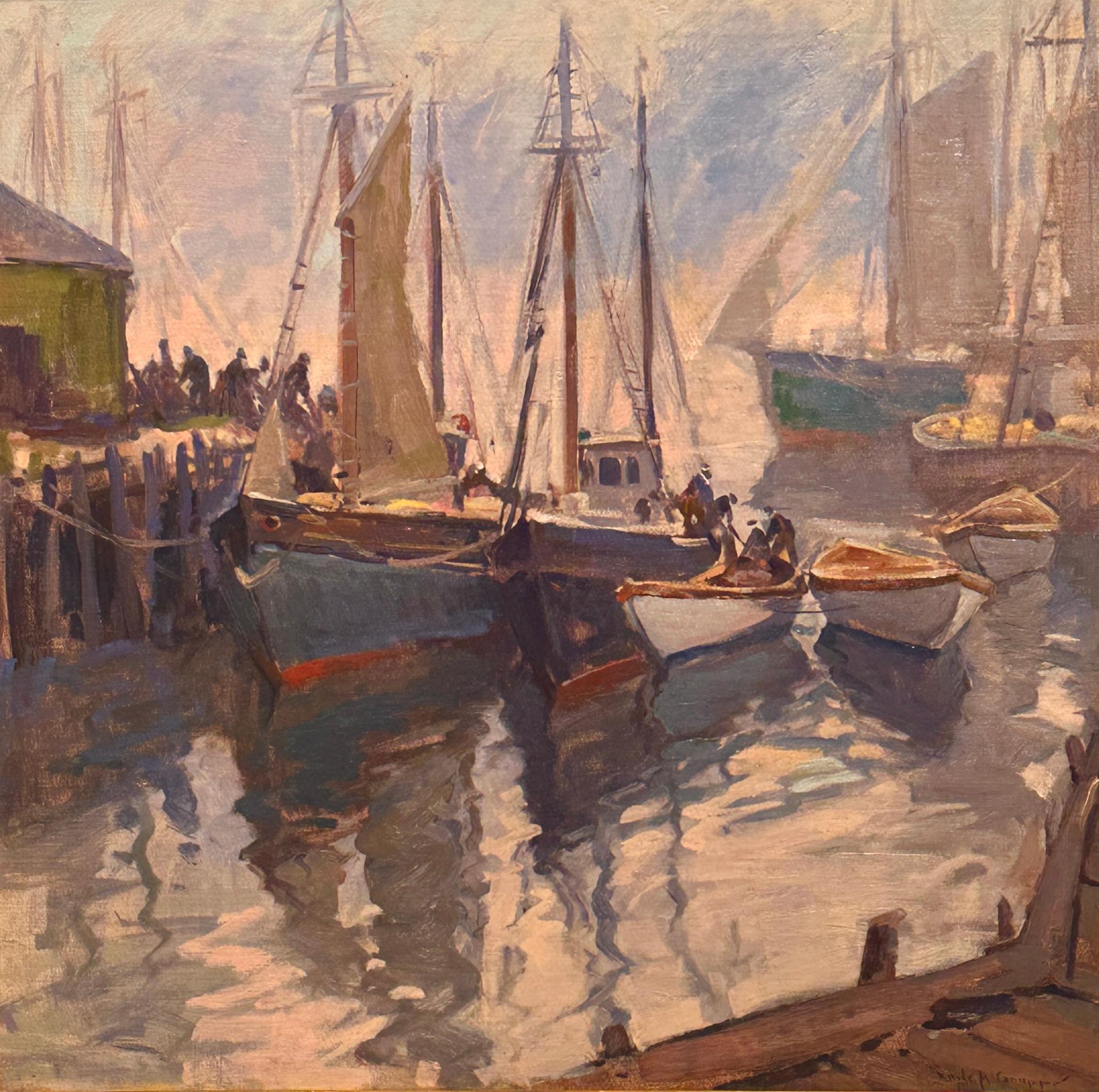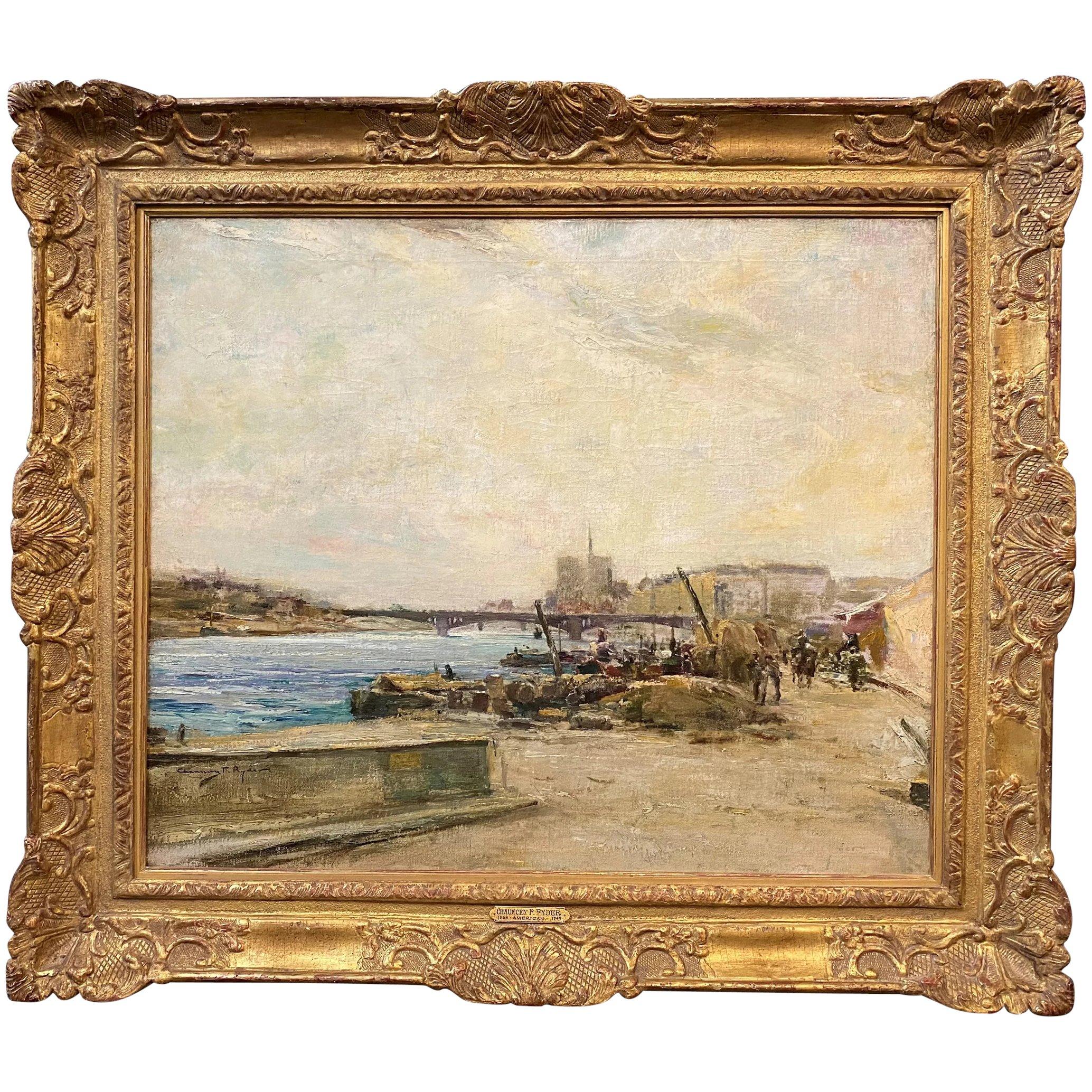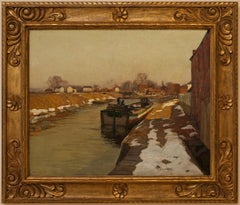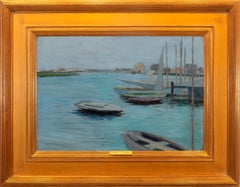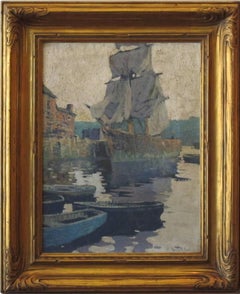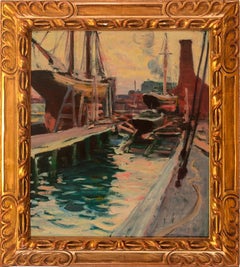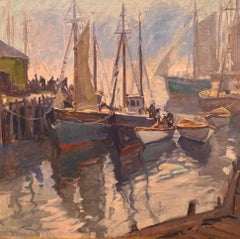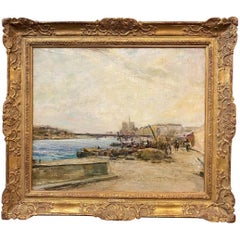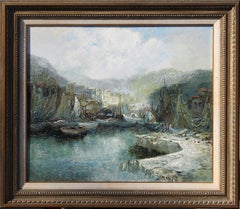Items Similar to "In Port"
Want more images or videos?
Request additional images or videos from the seller
1 of 6
Edward Willis Redfield"In Port"1908
1908
$781,250
£580,036.55
€675,902.20
CA$1,084,627.36
A$1,213,223.86
CHF 631,368.84
MX$14,935,199.39
NOK 8,032,319.91
SEK 7,535,899.45
DKK 5,042,904.70
Shipping
Retrieving quote...The 1stDibs Promise:
Authenticity Guarantee,
Money-Back Guarantee,
24-Hour Cancellation
About the Item
Jim’s of Lambertville is proud to offer this artwork by:
Edward Willis Redfield (1869 - 1965)
Edward W. Redfield was born in Bridgeville, Delaware, moving to Philadelphia as a young child. Determined to be an artist from an early age, he studied at the Spring Garden Institute and the Franklin Institute before entering the Pennsylvania Academy from 1887 to 1889, where he studied under Thomas Anshutz, James Kelly, and Thomas Hovenden. Along with his friend and fellow artist, Robert Henri, he traveled abroad in 1889 and studied at the Academie Julian in Paris under William Bouguereau and Tony Robert-Fleury. While in France, Redfield met Elise Deligant, the daughter of an innkeeper, and married in London in 1893.
Upon his return to the United States, Redfield and his wife settled in Glenside, Pennsylvania. He remained there until 1898, at which time he moved his family to Center Bridge, a town several miles north of New Hope along the Delaware River. Redfield painted prolifically in the 1890s but it was not until the beginning of the twentieth century that he would develop the bold impressionist style that defined his career. As Redfield’s international reputation spread, many young artists gravitated to New Hope as he was a great inspiration and an iconic role model. Edward Redfield remained in Center Bridge throughout his long life, fathering his six children there.
Around 1905 and 1906, Redfield’s style was coming into its own, employing thick vigorous brush strokes tightly woven and layered with a multitude of colors. These large plein-air canvases define the essence of Pennsylvania Impressionism. By 1907, Redfield had perfected his craft and, from this point forward, was creating some of his finest work.
Redfield would once again return to France where he painted a small but important body of work between 1907 and 1908. While there, he received an Honorable Mention from the Paris Salon for one of these canvases. In 1910 he was awarded a Gold Medal at the prestigious Buenos Aires Exposition and at the Panama-Pacific Exposition of 1915 in San Francisco, an entire gallery was dedicated for twenty-one of his paintings.
Since Redfield painted for Exhibition with the intent to win medals, his best effort often went into his larger paintings. Although he also painted many fine smaller pictures, virtually all of his works were of major award-winning canvas sizes of 38x50 or 50x56 inches. If one were to assign a period of Redfield’s work that was representative of his “best period”, it would have to be from 1907 to 1925. Although he was capable of creating masterpieces though the late 1940s, his style fully matured by 1907 and most work from then through the early twenties was of consistently high quality. In the later 1920s and through the 1930s and 1940s, he was like most other great artists, creating some paintings that were superb examples and others that were of more ordinary quality.
Redfield earned an international reputation at a young age, known for accurately recording nature with his canvases and painting virtually all of his work outdoors; Redfield was one of a rare breed. He was regarded as the pioneer of impressionist winter landscape painting in America, having few if any equals. Redfield spent summers in Maine, first at Boothbay Harbor and beginning in the 1920s, on Monhegan Island. There he painted colorful marine and coastal scenes as well as the island’s landscape and fishing shacks. He remained active painting and making Windsor style furniture and hooked rugs until the age of eighty. He died in Center Bridge, Pennsylvania, at ninety-six years of age.
Redfield, along with Garber, is considered a premiere figure among the Pennsylvania Impressionist painters. While in the prime of his career and considered to be of international greatness, his place in the future of American art history is yet to be defined. With the exception of John Singer Sargent, Redfield is said to have won more prizes, awards, and medals than any other American artist of the twentieth century. His work is in the permanent collections of many museums throughout the United States and abroad.
Source: New Hope for American Art, James Alterman
- Creator:Edward Willis Redfield (1869-1965, American)
- Creation Year:1908
- Dimensions:Height: 50 in (127 cm)Width: 63 in (160.02 cm)Depth: 5 in (12.7 cm)
- More Editions & Sizes:Framed Size 48" x 60"Price: $781,250
- Medium:
- Movement & Style:
- Period:
- Condition:
- Gallery Location:Lambertville, NJ
- Reference Number:Seller: PB00491stDibs: LU3745452711
About the Seller
5.0
Vetted Professional Seller
Every seller passes strict standards for authenticity and reliability
Established in 1997
1stDibs seller since 2014
38 sales on 1stDibs
Typical response time: 23 hours
- ShippingRetrieving quote...Shipping from: Lambertville, NJ
- Return Policy
Authenticity Guarantee
In the unlikely event there’s an issue with an item’s authenticity, contact us within 1 year for a full refund. DetailsMoney-Back Guarantee
If your item is not as described, is damaged in transit, or does not arrive, contact us within 7 days for a full refund. Details24-Hour Cancellation
You have a 24-hour grace period in which to reconsider your purchase, with no questions asked.Vetted Professional Sellers
Our world-class sellers must adhere to strict standards for service and quality, maintaining the integrity of our listings.Price-Match Guarantee
If you find that a seller listed the same item for a lower price elsewhere, we’ll match it.Trusted Global Delivery
Our best-in-class carrier network provides specialized shipping options worldwide, including custom delivery.More From This Seller
View All"The Canal"
By Edward Willis Redfield
Located in Lambertville, NJ
Jim’s of Lambertville is proud to offer this artwork.
Signed lower left. Complemented by a hand carved and gilt frame.
Illustrated in "Edward Redfield: Just Values and Fine Seeing" by Constance Kimmerle and the Pennsylvania Academy of the Fine Arts's Exhibition of Paintings by Edward Redfield (April 17 to May 16, 1909) brochure
Edward Willis Redfield (1869 - 1965)
Edward W. Redfield was born in Bridgeville, Delaware, moving to Philadelphia as a young child. Determined to be an artist from an early age, he studied at the Spring Garden Institute and the Franklin Institute before entering the Pennsylvania Academy from 1887 to 1889, where he studied under Thomas Anshutz, James Kelly, and Thomas Hovenden. Along with his friend and fellow artist, Robert Henri, he traveled abroad in 1889 and studied at the Academie Julian in Paris under William Bouguereau and Tony Robert-Fleury. While in France, Redfield met Elise Deligant, the daughter of an innkeeper, and married in London in 1893.
Upon his return to the United States, Redfield and his wife settled in Glenside, Pennsylvania. He remained there until 1898, at which time he moved his family to Center Bridge, a town several miles north of New Hope along the Delaware River. Redfield painted prolifically in the 1890s but it was not until the beginning of the twentieth century that he would develop the bold impressionist style that defined his career. As Redfield’s international reputation spread, many young artists gravitated to New Hope as he was a great inspiration and an iconic role model. Edward Redfield remained in Center Bridge throughout his long life, fathering his six children there.
Around 1905 and 1906, Redfield’s style was coming into its own, employing thick vigorous brush strokes tightly woven and layered with a multitude of colors. These large plein-air canvases define the essence of Pennsylvania Impressionism. By 1907, Redfield had perfected his craft and, from this point forward, was creating some of his finest work.
Redfield would once again return to France where he painted a small but important body of work between 1907 and 1908. While there, he received an Honorable Mention from the Paris Salon for one of these canvases. In 1910 he was awarded a Gold Medal at the prestigious Buenos Aires Exposition and at the Panama-Pacific Exposition of 1915 in San Francisco, an entire gallery was dedicated for twenty-one of his paintings.
Since Redfield painted for Exhibition with the intent to win medals, his best effort often went into his larger paintings. Although he also painted many fine smaller pictures, virtually all of his works were of major award-winning canvas sizes of 38x50 or 50x56 inches. If one were to assign a period of Redfield’s work that was representative of his “best period”, it would have to be from 1907 to 1925. Although he was capable of creating masterpieces though the late 1940s, his style fully matured by 1907 and most work from then through the early twenties was of consistently high quality. In the later 1920s and through the 1930s and 1940s, he was like most other great artists, creating some paintings that were superb examples and others that were of more ordinary quality.
Redfield earned an international reputation at a young age, known for accurately recording nature with his canvases and painting virtually all of his work outdoors; Redfield was one of a rare breed. He was regarded as the pioneer of impressionist winter landscape painting in America, having few if any equals. Redfield spent summers in Maine, first at Boothbay Harbor and beginning in the 1920s, on Monhegan Island. There he painted colorful marine and coastal scenes as well as the island’s landscape and fishing shacks. He remained active painting and making Windsor style furniture...
Category
Early 1900s American Impressionist Landscape Paintings
Materials
Canvas, Oil
"Sail Boats in Harbor"
By Edward Willis Redfield
Located in Lambertville, NJ
Jim’s of Lambertville is proud to offer this artwork by:
Edward Willis Redfield (1869 - 1965)
Edward W. Redfield was born in Bridgeville, Delaware, moving to Philadelphia as a youn...
Category
1890s American Impressionist Landscape Paintings
Materials
Canvas, Oil
"Harbor Reflections, Gloucester"
By Henry Bayley Snell
Located in Lambertville, NJ
Jim’s of Lambertville is proud to offer this artwork.
Signed lower right.
Complemented by a hand carved and gilt frame.
Henry Bayley Snell (1858 - 1943)
Henry Bayley Snell was born in Richmond, England, on September 29, 1858 and immigrated to the United States at the age of seventeen. He studied at the Art Students League in New York while working for an etching and engraving company where he began a lifelong friendship with fellow artists, William Langson Lathrop. While in New York Snell met another artist, named Florence Francis, also of English descent, whom he would eventually marry in 1888. It is believed that they first came to Bucks County in 1898 to visit the Lathrops at Phillips Mill.
Snell was a beloved teacher at the Philadelphia School of Design for Women from 1899 to 1943, and often took his art classes abroad during the summer. He would frequently visit his native England, spending time at the art colony of St. Ives on the coast of Cornwall. Snell would summer in Gloucester, Massachusetts, and Boothbay Harbor, Maine, where he also held painting classes. Almost all the women who exhibited with “The Philadelphia Ten” had studied with Snell either in Philadelphia or New England. Snell also taught on Saturdays at the Grand Central Galleries in New York City.
The Snells made many trips to New Hope before settling there permanently in 1925. They lived on the top floor of the Solebury National Bank Building where Henry also maintained a studio. This was located at the foot of the New Hope-Lambertville Bridge and many of Snell’s New Hope scenes were painted from this location. In 1943, Snell passed away in New Hope at the age of eighty-four.
Henry Snell earned an international reputation as an artist for his paintings of Cornwall...
Category
20th Century American Impressionist Landscape Paintings
Materials
Canvas, Oil
"Dry Dock"
By Henry Bayley Snell
Located in Lambertville, NJ
Jim’s of Lambertville is proud to offer this artwork by:
Henry Bayley Snell (1858 - 1943)
Henry Bayley Snell was born in Richmond, England, on September 29, 1858 and immigrated to the United States at the age of seventeen. He studied at the Art Students League in New York while working for an etching and engraving company where he began a lifelong friendship with fellow artists, William Langson Lathrop. While in New York Snell met another artist, named Florence Francis, also of English descent, whom he would eventually marry in 1888. It is believed that they first came to Bucks County in 1898 to visit the Lathrops at Phillips Mill.
Snell was a beloved teacher at the Philadelphia School of Design for Women from 1899 to 1943, and often took his art classes abroad during the summer. He would frequently visit his native England, spending time at the art colony of St. Ives on the coast of Cornwall. Snell would summer in Gloucester, Massachusetts, and Boothbay Harbor, Maine, where he also held painting classes. Almost all the women who exhibited with “The Philadelphia Ten” had studied with Snell either in Philadelphia or New England. Snell also taught on Saturdays at the Grand Central Galleries in New York City.
The Snells made many trips to New Hope before settling there permanently in 1925. They lived on the top floor of the Solebury National Bank Building where Henry also maintained a studio. This was located at the foot of the New Hope-Lambertville Bridge and many of Snell’s New Hope scenes were painted from this location. In 1943, Snell passed away in New Hope at the age of eighty-four.
Henry Snell earned an international reputation as an artist for his paintings of Cornwall...
Category
20th Century American Impressionist Landscape Paintings
Materials
Oil, Board
"The Shipyard Winter"
By Frederick R. Wagner
Located in Lambertville, NJ
Jim’s of Lambertville is proud to offer this artwork.
Signed lower left
Illustrated "New Hope for American Art"
Fred Wagner (1861 - 1940)
One of the earliest of the Pennsylvania...
Category
1910s American Impressionist Landscape Paintings
Materials
Oil, Canvas
"Steam Trawlers"
By Henry Bayley Snell
Located in Lambertville, NJ
Jim’s of Lambertville is proud to offer this artwork by:
Henry Bayley Snell (1858 - 1943)
Henry Bayley Snell was born in Richmond, England, on September 29, 1858 and immigrated to the United States at the age of seventeen. He studied at the Art Students League in New York while working for an etching and engraving company where he began a lifelong friendship with fellow artists, William Langson Lathrop. While in New York Snell met another artist, named Florence Francis, also of English descent, whom he would eventually marry in 1888. It is believed that they first came to Bucks County in 1898 to visit the Lathrops at Phillips Mill.
Snell was a beloved teacher at the Philadelphia School of Design for Women from 1899 to 1943, and often took his art classes abroad during the summer. He would frequently visit his native England, spending time at the art colony of St. Ives on the coast of Cornwall. Snell would summer in Gloucester, Massachusetts, and Boothbay Harbor, Maine, where he also held painting classes. Almost all the women who exhibited with “The Philadelphia Ten” had studied with Snell either in Philadelphia or New England. Snell also taught on Saturdays at the Grand Central Galleries in New York City.
The Snells made many trips to New Hope before settling there permanently in 1925. They lived on the top floor of the Solebury National Bank Building where Henry also maintained a studio. This was located at the foot of the New Hope-Lambertville Bridge and many of Snell’s New Hope scenes were painted from this location. In 1943, Snell passed away in New Hope at the age of eighty-four.
Henry Snell earned an international reputation as an artist for his paintings of Cornwall...
Category
20th Century American Impressionist Landscape Paintings
Materials
Oil, Board
You May Also Like
Emile Gruppe, Gloucester Harbor Scene by American Impressionist Painter
By Emile Gruppe
Located in Rockport, MA
Emile Gruppé beautifully captures a busy Gloucester harbor scene with fishermen tending to their boats—a signature subject for the artist. This example is pre-1945.
Gruppé was reno...
Category
20th Century American Impressionist Landscape Paintings
Materials
Oil
Along The Seine
By Chauncey Foster Ryder
Located in Milford, NH
A fine impressionist landscape along the Seine River in France by American artist Chauncey Foster Ryder (1868-1949). Ryder grew up in New Haven, Connec...
Category
Early 1900s American Impressionist Landscape Paintings
Materials
Canvas, Oil
Harbor Scene
By Hayley Lever
Located in Milford, NH
A fine impressionist oil marine harbor scene painting by Australian American artist Hayley Lever (1876-1958). Lever was born in Adelaide, Australia and studied first at the Adelaide...
Category
Early 20th Century American Impressionist Landscape Paintings
Materials
Oil, Board
$28,000
"Docked at the Bay", Willi Bauer, Oil/Canvas, 27x31, Impressionist Cityscape
By Willi Bauer
Located in Dallas, TX
Willi Bauer is a contemporary German painter known for his Impressionist-styled depictions of garden parties and rustic villages. His paintings are composed of all aspects of life fr...
Category
1980s Impressionist Landscape Paintings
Materials
Canvas, Oil
An Unfrequented Harbor
Located in Milford, NH
A fine impressionist marine painting of a harbor on Cape Ann, Massachusetts by American artist Harry Aiken Vincent (1867-1933). Vincent was Born in...
Category
Early 20th Century American Impressionist Landscape Paintings
Materials
Canvas, Oil
The Port of Newcastle Upon Tyne - British 1914 marine art oil painting
By Joseph Henry Kirsop
Located in London, GB
This lovely historically interesting British marine oil painting is by Newcastle artist Joseph Henry Kirsop. Painted in 1914, the location of the painting is the port of Newcastle up...
Category
1910s Realist Landscape Paintings
Materials
Oil
$6,165 Sale Price
20% Off
